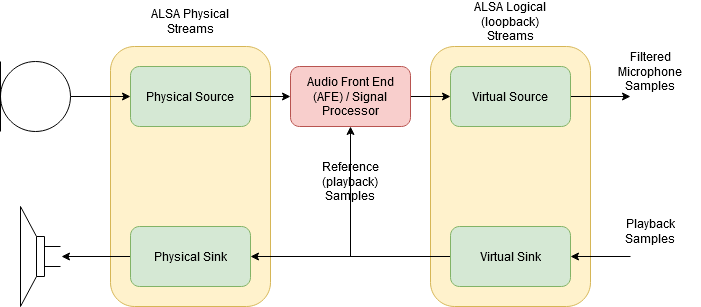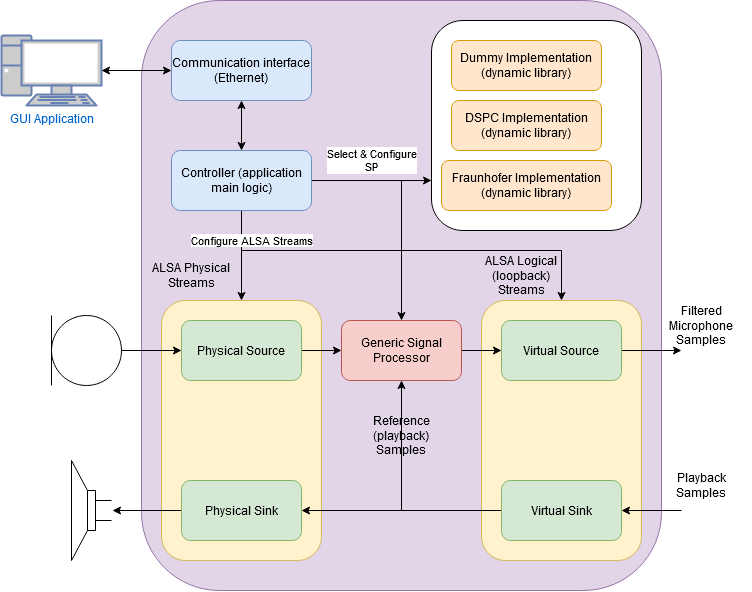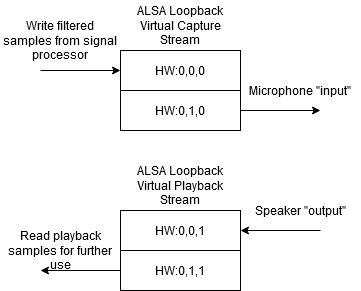Audio Front End (AFE) repository for solutions incorporating Voice Assistants like Alexa from Amazon, etc.
To be able to precisely detect human language, the gathered signal from microphone must be clean without any echo, noise and other disturbances. To filter out noise, echo etc. a microphone array is used. Based on the number of microphones the input into the embedded device consists of several microphones (usually) interleaved signals. Such a compound signal should be fed into a signal processor (commonly known as Audio Front End), which filters out noise, echo and other disturbances. The output from the signal processor is the desired single channel clear microphone audio, which is used for further processing (word detection and natural language utilization).
To interface the audio on Linux OS, the Advanced Linux Sound Architecture (ALSA) library is used. The signal processing is handled by a signal processor (AFE) provided by a proprietary library from a third party vendor. The whole situation is depicted on following picture.
As depicted on the audio chain picture, there are two main problems:
- AFE
- Audio Streams
From this perspective it's not possible to replace one vendor with another, as this would need to rewrite the code and reconfigure the audio streams with every new AFE vendor.
To overcome the issues with different AFE vendors and reconfiguration of audio streams we defined an NXP AFE. From this perspective, the NXP AFE is not just a signal processor, rather it's a complex controller allowing to load signal processors from different vendors and based on provided settings configure all the necessary streams to make the whole audio chain functional. Further it would allow to communicate over ethernet to change the audio chain configuration on fly. The architecture is depicted on the following picture.
To allow the change between signal processors a generic Signal Processor API has been defined - pure virtual base class (named SignaProcessorImplementation). The purpose of this class is only to define the interface for the Signal Processor and it's capabilities.
The third party libraries can be wrapped into a new class derived from SignalProcessorImplementation base class and compiled into a dynamic library. The library can be afterwards dynamically loaded/unloaded, which overcomes all the issues:
- we can interchange the AFE from different vendors without the need of rewriting the source code
- we can switch the AFE on fly (if necessary), no need to stop/start the application
The src/SignalProcessor/SignalProcessorImplementation.h header defines the base class. An example of how to use this interface is demonstrated on a dummy signal processor implementation found under src/SignalProcessor_Dummy.cpp/h.
One of the most important part of the base class is, that the derived class must report it's options and possible configurations using a JSON format as a string. This can be used either for some automated configuration or with conjunction with a GUI based app. This GUI based app would allow the user in a friendly manner configure the signal processor.
The ALSA library represents an interface between the HW and the SW and can be used to read/write samples from/to streams.
To ease the use of ALSA, a simple class hierarchy for audio streams has been defined and is located under src/AudioStream/.
Before we can provide clean microphone signal to the audio assistant, we need to filter out the microphone signals with the use of playback (reference signal). This has the following consequences:
- we need to read captured samples
- we need to modify the chain in a way, that we can read out playback samples before they are being played
- we need to write the filtered microphone signal somewhere, so the applications can have access to it
ALSA provides a solution to the above points using ALSA loopback virtual device(s). This device allows us to read back written values. So we configure the chain in a way, that all applications playing audio will write into this device, so we can read the playback samples for further use. For the capture stream, we need to define the devices in such a way, that the applications will read out from this loopback device while we will write the filtered samples into this device. Picture below provides a more detailed insight into the loopback configuration.
We need to define our own ALSA configuration to support the abovementioned approach. This can be found under misc/ in "asound.conf" file. Specific configurations can be stored either under /etc/asound.conf or under $HOME/.asoundrc.
The src/main.cpp represents an example how to use the audio stream class in conjunction with the signal processor classes to load an implementation and filter the signals.
The project is designed to work on our i.MX family, but it could be used on any Linux base system.
While we are still in the process of finalizing and refining the NXP AFE, further development is under consideration.
Make sure you have installed the libasound library in order to be able to build the project.
Cd to <project_folder> and execute "make".
This would create a build directory with binary under <project_folder>/build/bin/.
Cd to <project_folder>/src/SignalProcessor and execute "make".
This would create a build directory with the binary under /build/bin.


